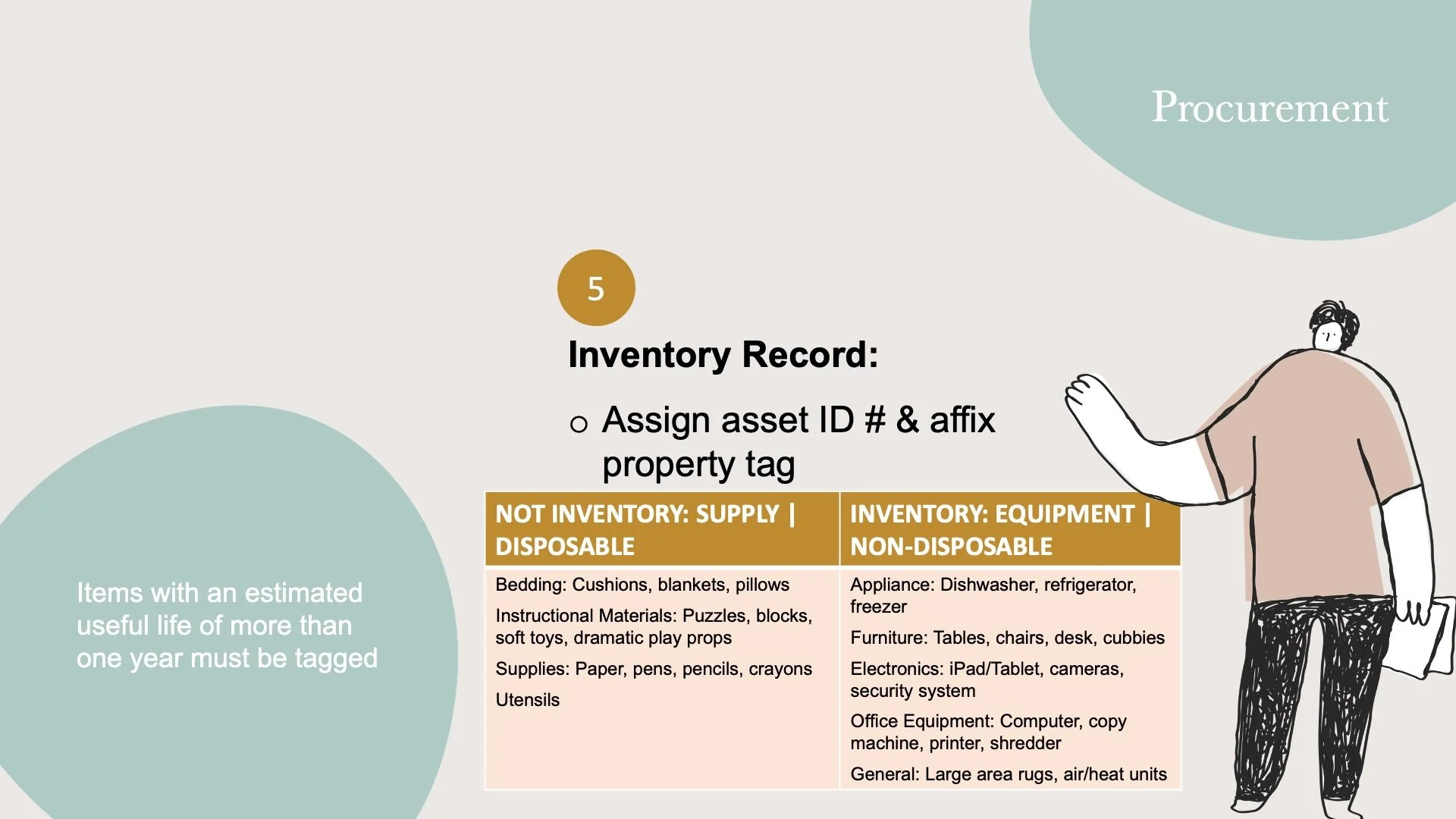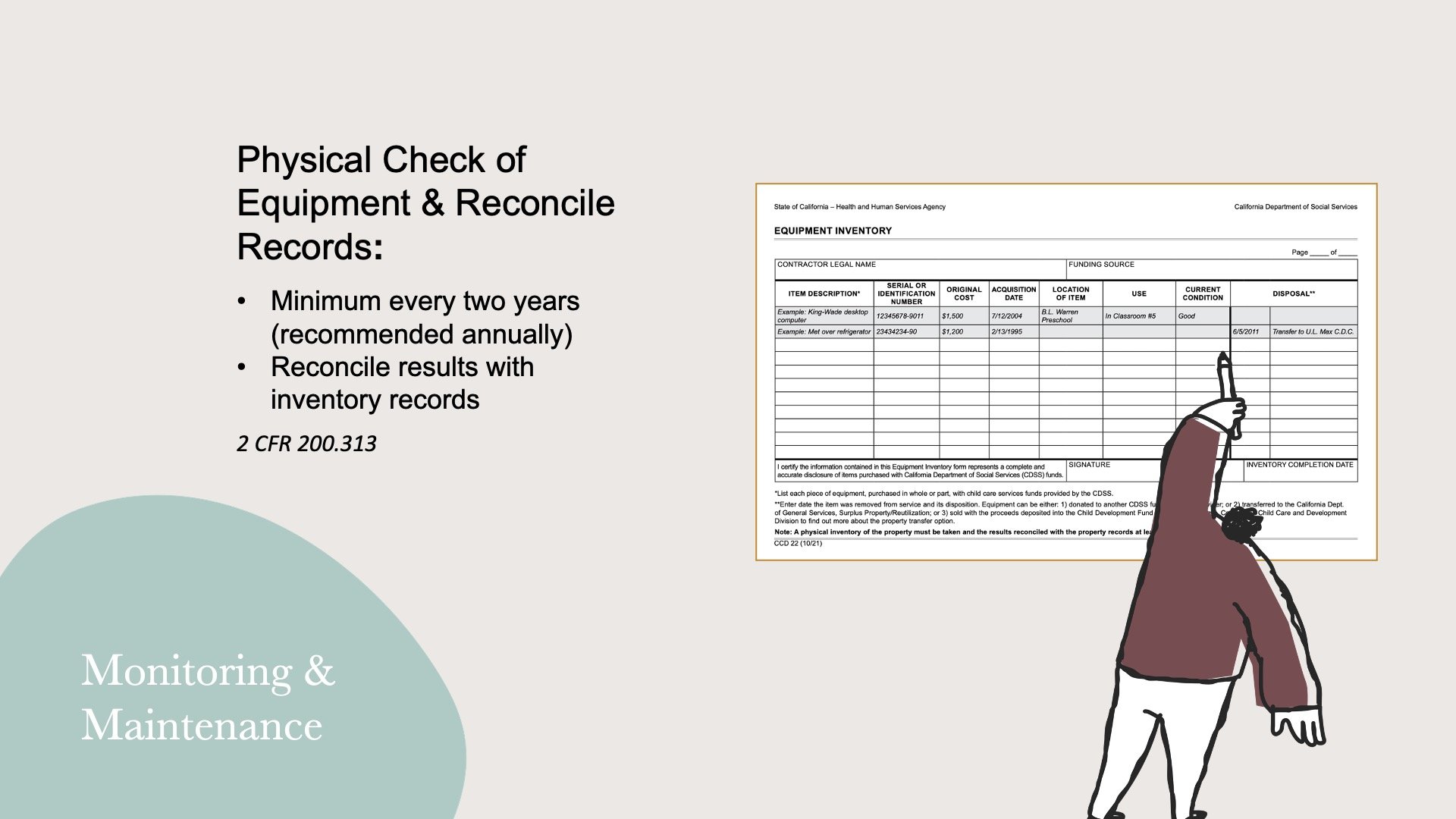Lesson 9
Inventory Records
Compliance Indicator
The contractor has adopted procedure for managing equipment, purchased in whole or in part with early learning & care contract funds, until disposition of the item. In addition the requirements above, the contractor has:
A control system to ensure adequate safeguards to prevent loss, damage, or theft of the property & to investigate any loss, damage, or theft
Adequate maintenance procedures to keep the property in good condition
Proper sales procedures to ensure the highest possible return in the event the contractor is authorized or required to sell the item
Regulations/Reference
CCD Program Instrument: IV. Administrative CCD 16
Education Code: 35168
Title 5: 3946 & 18025
45 Code of Federal Regulations: 75.320[d][3], [4] & [5]
2 Code of Federal Regulations: 200.313[d][3], [4] & [5]
Monitoring Review Evidence
Inventory Record containing:
e) Cost
f) Location, use & condition
g) Any ultimate disposition date including date of disposal & sale price, if applicable
a) Description
b) Serial number
c) Source of funding
d) Acquisition date
Written Policies and Procedures for Competitive Procurement
Inventory Tagging of Larger Items
Watch Video Lesson ❯
Sample Forms/Tools ❯
Review Sketch Pad Notes ❯
Inventory Management System
Below is a snapshot of a SAMPLE Inventory Management System that is broken down into 4 categories: Procurement, Recordkeeping, Monitoring & Maintenance, and Inventory Updates.
Procurement
Contractors are required to have adopted procedures regarding the procurement of goods & services that prohibit conflicts of interest & ensure competition in place.
What might a procurement process look like:
Identify Program Need
Beyond ongoing purchase requests & maintenance work orders, organizations should have a control system in place that identifies when large purchase items will depreciate & need replaced. This could be anything from computers to replacing a roof on a building.
Evaluate
The purchase needs must be evaluated to determine if it’s an allowable reimbursable expense.
Determine if pre-approval is required
All equipment purchases, replacements & improvements must be approved in advance.
& have at least 3 bids or estimates if the per-unit cost equals or exceeds $5000, including tax,
OR if the sum of all items related to the purchase exceeds $10,000.
If 3 bids cannot be obtained, the contractor must provide documentation of the reason the bids could not be obtained.
If an item that exceeds the specific thresholds, contractors complete & submit the Equipment Purchase Approval Request (CCD 9)
Purchase
After the purchase of goods or services has been determined to be an allowable expense, staff move forward with the purchase.
The contractor must purchase the goods or services from the lowest responsible bidder or estimate, along with charging to the applicable program.
Receive Order
When the product is received, a process must be in place to ensure the product is not damaged.
Once order is accepted, move forward with approving it for payment if ordered through the purchase order process.
Inventory Record
Items with an estimated useful life of more than one year must be tagged. Examples of tagging options might include adhesive labels with numbers or bar codes.
Note: If the item is received outside of the central receiving location, a property tag & instructions must be sent to the site to ensure it becomes part of the inventory.
Document the minimum requirements as outlined in the compliance indicator & Funding Terms & Conditions (type, model, serial #, etc…)
Deployment
Deliver the items to its location
Recordkeeping
An inventory record must be maintained for each piece of equipment & non-disposable items, with an estimated useful life of more than one year purchase, purchased in whole or in part with early learning & care contract funds.
Most contractors have an electronic database used to maintain their inventory record that includes the minimum inventory record requirements.
If an agency does not have an electronic database, the California Department of Social Services has a template, form CCD 22, that may be used.
Monitoring & Maintenance
An asset control system must be in place to ensure adequate maintenance procedures are in place to keep equipment in good condition that includes taking physical inventory for the purpose of verifying the physical existence of property& equipment.
Physical inventory must be taken & results reconciled with inventory records at least once every 2 years. Any differences between quantities determined by the physical inspection & those shown in the accounting inventory records should be investigated to determine the causes of the differences.
NOTE: CDSS recommends that a physical inventory of property & equipment be taken at least annually.
What this might look like in a program:
Full inventory physical check is conducted annually.
Documentation of the most recent physical check of the inventory is maintained within the database.
To ensure adequate safeguards to prevent loss, damage, or theft of the property, the control system includes:
Alarm systems with cameras throughout each building
Staff are aware that Inventory Records must be updated within the database when items are moved from one location to the other. The Inventory Record is used to document disposal or transfer of any equipment
Business office representative conducts a random spot check quarterly
Sales Procedure
Contractors are required to have adopted procedures regarding proper sales of items to ensure the highest possible return in the event the contractor is authorized or required to sell the item.
What this might look like in a program:
Procedure includes an annual physical inventory of property or equipment along with maintaining property and equipment in good condition.
Complete Knowledge Check ❯
After reviewing the video lesson & sketch pad notes, it’s time to check for understanding by completing a Knowledge Check. Note that Individual Knowledge Checks will conclude with a Certificate.










